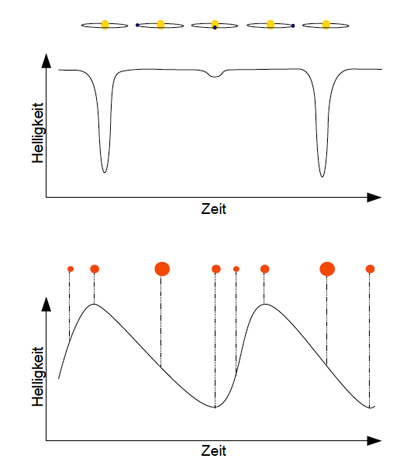The observation of variable stars is the most fertile area for cooperation between professional and amateur astronomers. Many stars change their brightness over time either because they are obscured by a close companion star or because of physical processes on or in the star. The large number of variable stars cannot be supervised continually by professional astronomers.
Since many variables remain bright enough throughout their cycle to be visible in binoculars, virtually anyone can make a contribution to research if he has enough endurance to do a monitoring program for a long time. Although the brightness estimation requires some practice, it is easy when you have good star charts. You simply compare the brightness of a variable star with those of neighboring stars with a known brightness and record date and brightness. Star charts can be created by an astronomy program with a good data base.
The American Association of Variable Star Observers (AAVSO) offers star charts, collects results and can help you with any questions. Their website is at http://www.aavso.org.
Eclipsing binaries show predictable light curves, since they have a drop in brightness when a component of a double star is in front of or behind its companion. The best known representative of this class is Algol (β Persei, the „Demon Star in Perseus“). Its brightness decreases every 2.87 days for 10 hours from 2.1 to 3.4m.

For eclipsing binaries from Algol-type (above) brightness dips in the light curve occur when a star is hidden by its companion. Depending on the orbital inclination and the nature of the two stars, the minima will vary.
For long period variables or in pulsating variables (below), the brightness varies with the diameter of the star.
Pulsating stars are stars whose diameter changes regularly. Long period variables (so-called Mira stars) are old red giant stars such as Mira (ο Ceti), whose brightness varies over 80-1,000 days by up to ten magnitudes. The period between two maxima is not always exactly the same. The short period Cepheids are bright, pulsating super giants. They show a fixed relationship between period and absolute brightness and can be used to measure distances to star clusters. The namesake of this class is δ Cephei, its brightness varies within 5.4 days from 3.6 to 4.4m.
Eruptive variables show the most unpredictable brightness variations. This class contains novae and supernovae as well as very young stars or the R Coronae Borealis stars, where dark soot clouds conceal the view on the surface.
